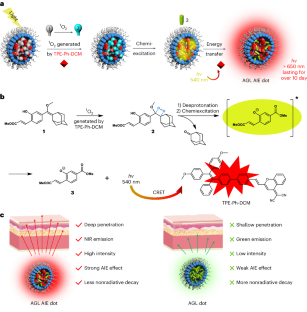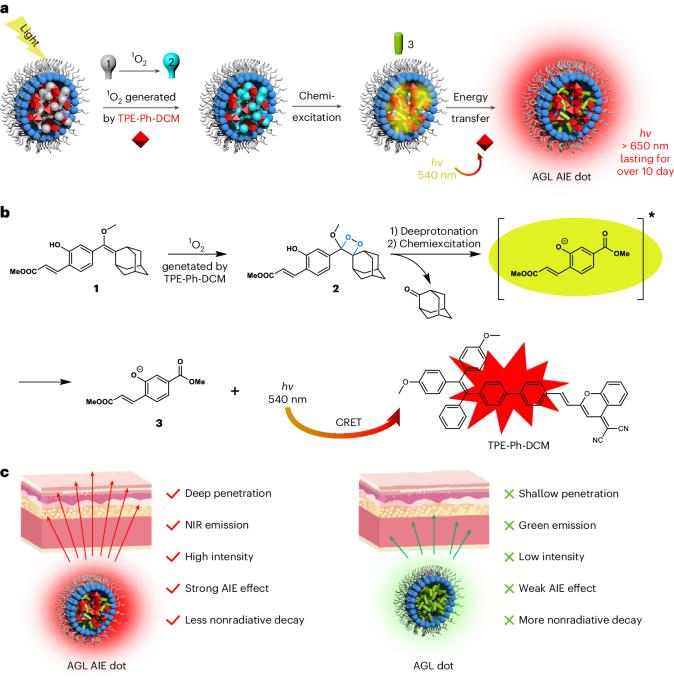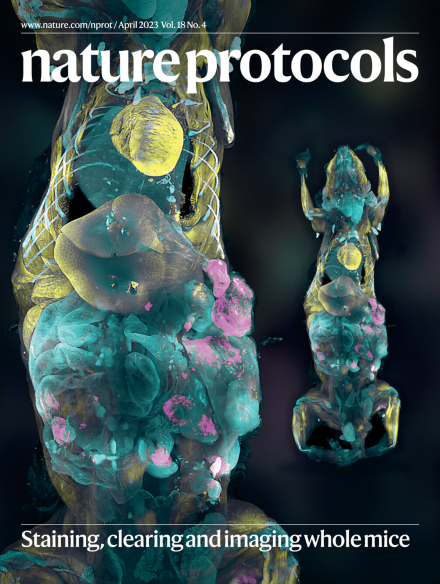制备基于 AIEgen 的近红外余辉发光纳米探针,用于肿瘤成像和图像引导的肿瘤切除术
IF 13.1
1区 生物学
Q1 BIOCHEMICAL RESEARCH METHODS
引用次数: 0
摘要
荧光成像是现代生物学、肿瘤学和生物医学应用的重要工具。余辉发光(AGL)可以规避与实时激发光源相关的光散射和组织自发荧光干扰,显著提高成像灵敏度和深度。在此,我们介绍了一种设计和合成具有聚集诱导发射(AIE)效应的 AGL 纳米探针的方法,该探针可同时红移和放大余辉信号,用于肿瘤成像和图像引导下的肿瘤切除。该纳米探针(AGL AIE dot)由 Schaap 药剂的烯醚形式和近红外 AIE 荧光剂(AIEgen)(四苯乙烯-苯基-二氰基亚甲基-4H-色烯,TPE-Ph-DCM)组成,以抑制非辐射耗散途径。用白光预先照射 AGL AIE 点可产生单线态氧,将沙普剂转化为 1,2-二氧杂环丁烷形式,从而启动 AGL 过程。在 AIEgen 的帮助下,AGL 同时显示了红移发射最大值(从约 540 纳米到约 625 纳米)和增强的强度(3.2 倍),从而提高了信噪比、成像灵敏度和深度。有趣的是,激活的 AGL 可持续 10 多天。与传统方法相比,我们的方法为同时红移和放大余辉信号以获得更好的体内成像效果提供了一种新的解决方案。制备 AGL AIE 点阵需要约 2 天,体外表征需要约 10 天(如果不涉及余辉动力学曲线研究,则不到 1 天),肿瘤成像和图像引导的肿瘤切除需要约 7 天。经过化学合成和动物处理方面的标准实验室培训后,这些程序可以很容易地复制和修改。本文章由计算机程序翻译,如有差异,请以英文原文为准。


Preparation of AIEgen-based near-infrared afterglow luminescence nanoprobes for tumor imaging and image-guided tumor resection
Fluorescence imaging represents a vital tool in modern biology, oncology and biomedical applications. Afterglow luminescence (AGL), which circumvents the light scattering and tissue autofluorescence interference associated with real-time excitation source, shows remarkably increased imaging sensitivity and depth. Here we present a protocol for the design and synthesis of AGL nanoprobes with an aggregation-induced emission (AIE) effect to simultaneously red shift and amplify the afterglow signal for tumor imaging and image-guided tumor resection. The nanoprobe (AGL AIE dot) is composed of an enol ether format of Schaap’s agent and a near-infrared AIE fluorogen (AIEgen) (tetraphenylethylene-phenyl-dicyanomethylene-4H-chromene, TPE-Ph-DCM) to suppress the nonradiative dissipation pathway. Pre-irradiating AGL AIE dots with white light could generate singlet oxygen to convert Schaap’s agent to its 1,2-dioxetane format, thus initializing the AGL process. With the aid of AIEgen, the AGL shows simultaneously red shifted emission maximum (from ~540 nm to ~625 nm) and enhanced intensity (by 3.2-fold), facilitating better signal-to-background ratio, imaging sensitivity and depth. Intriguingly, the activated AGL can last for over 10 days. Compared with conventional approaches, our method provides a new solution to concurrently red shift and amplify afterglow signals for better in vivo imaging outcomes. The preparation of AGL AIE dots takes ~2 days, the in vitro characterization takes ~10 days (less than 1 day if not involving afterglow kinetic profile study) and the tumor imaging and image-guided tumor resection takes ~7 days. These procedures can be easily reproduced and amended after standard laboratory training in chemical synthesis and animal handling. This protocol describes the preparation of long-lasting aggregation-induced emission-based, near-infrared afterglow luminescence nanoprobes. Their enhanced afterglow intensity results in improved imaging sensitivity and depth in vivo.
求助全文
通过发布文献求助,成功后即可免费获取论文全文。
去求助
来源期刊

Nature Protocols
生物-生化研究方法
CiteScore
29.10
自引率
0.70%
发文量
128
审稿时长
4 months
期刊介绍:
Nature Protocols focuses on publishing protocols used to address significant biological and biomedical science research questions, including methods grounded in physics and chemistry with practical applications to biological problems. The journal caters to a primary audience of research scientists and, as such, exclusively publishes protocols with research applications. Protocols primarily aimed at influencing patient management and treatment decisions are not featured.
The specific techniques covered encompass a wide range, including but not limited to: Biochemistry, Cell biology, Cell culture, Chemical modification, Computational biology, Developmental biology, Epigenomics, Genetic analysis, Genetic modification, Genomics, Imaging, Immunology, Isolation, purification, and separation, Lipidomics, Metabolomics, Microbiology, Model organisms, Nanotechnology, Neuroscience, Nucleic-acid-based molecular biology, Pharmacology, Plant biology, Protein analysis, Proteomics, Spectroscopy, Structural biology, Synthetic chemistry, Tissue culture, Toxicology, and Virology.
 求助内容:
求助内容: 应助结果提醒方式:
应助结果提醒方式:


